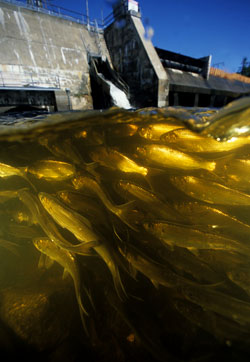
Alewives, Heather PerryAlewife ladder, Damariscotta Mills photo.
If he had come a week earlier, or a week later, the water would have been roiling with fish. Still, Bowdoin biologist John Lichter can’t contain his excitement.
“Look at the osprey,” he says, pointing at a pair of fish hawks swooping over the pond with a shrieking cry. “Looking for breakfast, I guess.”
Their prey is the lowly alewife, an anadromous herring that for centuries has been making a tortuous spawning run from the ocean, up the Damariscotta River, to Damariscotta Lake. A bout of cold spring weather has kept them massing at the pond below the lake, waiting out their ascent for warmer weather.
When they decide to make a run up the restored fish ladder—a chain of small masonry ponds rising along the stream bed—the ospreys will have an easy time of it. Alewives will fill these waters, pool by pool, climbing some 42 vertical feet by the thousands.
The fish ladder in Damariscotta Mills is one of the few places in Maine where you can still see this sight. Alewives have declined dramatically in the past century, as widespread damming and river pollution have destroyed much of their spawning habitat.
According to a recent story in the Portland Press Herald, East Coast alewife harvesters in the 1950s netted some 70 million pounds of river herring, which are a popular source of bait for lobstermen. Today, fewer than one million pounds are harvested.
“Historically, this small fish came to spawn in Maine lakes by the millions,” says Lichter as he makes his way along a pedestrian walkway constructed beside the falling water. “When the young left in the late summer, early fall, they would number in the billions.”
“Historians write about how they were so plentiful at the time the country was settled that bears and swine crowded on the shores by the thousands to feed on them in the water. All of the rivers along coastal Maine were important alewife production habitat.”
Maine’s robust alewife population is significant for another reason: River herring have been an important food source for most major near-shore fish populations in the Gulf of Maine.A walkway along the Damariscotta Mills fish ladder offers viewing points for pools teeming with alewives. Recent studies have correlated the abundance, and subsequent decline, of groundfish such as cod, with the fish that once crowded the mouths of Maine’s major river ways.
Some researchers—including Lichter—believe that the resurgence of the lowly river herring may be one key to restoring groundfish populations in the Gulf of Maine.
Lichter is part of a five-year research collaborative with scientists and economists from Bowdoin, Bates College and the University Southern Maine who are studying past and present alewife populations in the Kennebec and Androscoggin watersheds.
The scientists will sample lake and estuarine sediments in search of a chemical signal past fish have brought in
from the marine environment to the freshwater system that will serve as a proxy of their past abundance. Finally they will develop methods to determine whether cod are using the alewives that are actually there.
“We’ll use Damariscotta Lake as a case study,” he says, surveying a vintage harvesting conveyor apparatus set up at the bottom of the fish ladder. “There is a good record of how many alewives have come into the lake.”
One of the researchers in the group is fisherman-researcher Ted Ames, who will be a Bowdoin Coastal Studies Center Scholar-in-Residence for the 2010-11 academic year. Ames won a MacArthur Genius Award for his studies on the evolution of fishing patterns in the Gulf of Maine that combine both fishery science and fishermen’s knowledge.
“Ted identified four near-shore populations of cod that were each centered at one of the Maine rivers,” notes Lichter. “The final collapse occurred when the rivers got really dirty. He speculated that it happened because the forage base collapsed. The cod were there because of the alewives coming in and back out again.”
Lichter stops at one bend in the stream where a large pool is filling with alewives. He snaps off a round of photos.
“This restored fish run is a good example of what some of the natural resources could be like with some stimulation for recovery,” he says. “In the last couple of years they’ve had 100,00 to 200,000 alewives pass up into the lake. It’s a good sign.”
The ospreys seem to agree. One dive-bombs into the pond with a splash and emerges, flapping, with a slivery fish in its talons.
This research is supported by the National Science Foundation’s Experimental Program to Stimulate Competitive Research (EPSCoR).
Story published by Bowdoin College.


